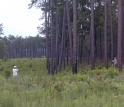News Release 05-110
Landscape Corridors Provide Pathway for Seed Dispersal
Birds help habitats maintain diversity

Seeds were more often found in the central clearings of connected patches than in isolated ones.
June 30, 2005
This material is available primarily for archival purposes. Telephone numbers or other contact information may be out of date; please see current contact information at media contacts.
Wildlife corridors--clear tracts of land intended to help maintain biodiversity by allowing animals to move between otherwise isolated natural areas--may also aid stationary plants in the same way. A study at an outdoor experimental landscape in S.C., has found that berry eating bluebirds transfer more of the plants' seeds between habitats connected by corridors than between those that are unconnected.
The study, which appears this week in the journal Science, is important because it suggests that greenways in urban and suburban communities help plants as well as animals.
"The work illustrates how basic research, in this case studying bird behavior, can provide important information needed in land management decisions," said Alan Tessier, program director in NSF's division of environmental biology, which funded the research.
Habitat fragmentation poses a widespread threat to biodiversity by disrupting the dispersal of organisms, said Doug Levey, a zoologist at the University of Florida and lead author of the paper. "Corridors--narrow strips of habitat that join patches of similar habitat--are thought to provide a solution by restoring dispersal of species among patches," he said.
According to Levey, the experiment's scale is unique in wildlife corridor research, which has tended to focus on smaller sites. The researchers used a computer model to extrapolate records of bluebird movement from small areas to large landscapes--painting a much broader picture than available through observation alone.
"We examined the effect of habitat corridors on long-distance dispersal of seeds by birds, and tested whether small-scale (less than 20 meters) movements of birds could be 'scaled up' to predict dispersal of seeds across hundreds of meters," Levey said.
Levey and his colleagues collaborated with the U.S. Forest Service to set up the experimental landscape, which lies in the Savannah River Site National Environmental Research Park, a 482-square-mile federally protected research area on the S.C.-Ga. state line.
The biologists carved out sets of clearings in the forest. In one group, habitat corridors connected central clearings to peripheral clearings. In the other group, the central clearings remained separated by forest.
The biologists placed wax myrtle branches with ripe berries in the central clearings, marking the berries with a harmless florescent dye so that they could track the berries' whereabouts. The researchers also placed seed traps under bluebird perches in both the connected and isolated central clearings. Using the florescent markers, they were able to identify seeds that came from plants in the central patches.
The results were clear: on average, seeds in traps were more likely to be found in the central clearings of connected patches than in the central clearings of isolated patches.
Levey said that the success of the research demonstrates promise for studies aimed at predicting long-distance movements of elusive animals such as bears, wolves and panthers. "The study shows that models based on easily observed behaviors indeed can be used to predict landscape-level processes."
Co-authors of the Science paper are Ben Bolker, also at UF; Joshua Tewskbury, of the University of Washington; Sarah Sargent, of Allegheny College in Pennsylvania; and Nick Haddad, of North Carolina State University.
-NSF-
-
Researchers record the movements of a bluebird along the edge of a forest in South Carolina.
Credit and Larger Version -
The grayish fruits of wax myrtle (foreground) are a favorite food for many wild birds.
Credit and Larger Version
Media Contacts
Cheryl Dybas, NSF, (703) 292-7734, email: cdybas@nsf.gov
Aaron Hoover, University of Florida, (352) 392-9169, email: ahoover@ufl.edu
The U.S. National Science Foundation propels the nation forward by advancing fundamental research in all fields of science and engineering. NSF supports research and people by providing facilities, instruments and funding to support their ingenuity and sustain the U.S. as a global leader in research and innovation. With a fiscal year 2023 budget of $9.5 billion, NSF funds reach all 50 states through grants to nearly 2,000 colleges, universities and institutions. Each year, NSF receives more than 40,000 competitive proposals and makes about 11,000 new awards. Those awards include support for cooperative research with industry, Arctic and Antarctic research and operations, and U.S. participation in international scientific efforts.
Connect with us online
NSF website: nsf.gov
NSF News: nsf.gov/news
For News Media: nsf.gov/news/newsroom
Statistics: nsf.gov/statistics/
Awards database: nsf.gov/awardsearch/
Follow us on social
Twitter: twitter.com/NSF
Facebook: facebook.com/US.NSF
Instagram: instagram.com/nsfgov




